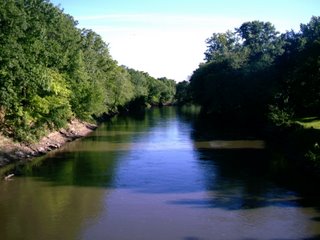
Day 35-37 Quincy Mile 384
Oct. 8-10, 1838 May 27-28, 2006
This was an entire city moving to Kansas—young people, babies, pregnant women, middle aged men with bad knees, the elderly. It would be like going down the street to select in order 900 people from your neighborhood announcing they are about to walk to Kansas. And they had white militia guarding them, plus wagon-drivers on contract with the government. All this mixed group of people had more to do than travel. There were moccasins to make, clothes to wash, wagon spokes to repair and salaries to the contract workers to be paid. The party did this on the west shore of the Mississippi facing Qunicy.
When the Indians passed through Quincy they attended the St. Boniface church-a brand new congregation of German Catholics. Quincy was at the time perhaps 300 people, with 250 of them being German Catholics. Their little frame church had just been built that year and this is the only constructed church the Catholic Indians worshipped in since they had left behind in Twin Lakes the beloved log chapel they had built with their own hands when they heard that they’d get a priest.
Accounts were organized and the officers, laborers and wagoners were paid. Two soldiers and a wagoner decided they’d had enough and requested discharge to go home—and they were left go. There were talks to hold—with several of the chiefs meeting with Polke asking that they not travel any more on the “Sabbath” so they could hold “devotional exercises.” Our intermittent Doctor Jerolaman returned to the party here in Quincy, having joined the party late then gotten sick Septermber 24, left the party in Springfield the 29th and now returned to work October 9th—having just missed about 25% of the trip in this instance alone—it will be interesting to see if he is “docked” for this when he is paid at the end of the trip (the payment records still exist).
These days were given to organizing, paying, sorting, packing and repacking the wagons along with shoeing the horses and repairing the wagons for the second half of the trip. All this required them to ferry back and forth into town for supplies since they were camping on the opposite shore from town. The official journal spins the frequent shuttles this way: “This might have been avoided by remaining on the Quincy shore, but the dissolute habits of the Indians and their great proneness to intoxication, forbid such a step...” This seems to be a change of tone in the journal from previous entries where the writer seems to brag about “nothing of the sort” of drunkenness being allowed. And it is particularly hard on the Indians, many of which were Catholics committed to total abstinence. What had changed?
By evening of October 10th they were ready to push on for their second leg of the journey.
AS FOR ME I too took several days off in Quincy with Sharon. We both had a delightful supper with Steve & Janet Tieken. Steve is an Archeologist and plans to walk with me Monday through Quincy. Also got to interview the priest at St. Boniface church and attend a service there. The rest of the weekend was spent on sleeping and giving myself to purposeful laziness in order to charge my batteries physically for the walk across Missouri which Shirley Willard (the foremost historian on the Trail of Death) warns me will be like walking through a ninety degree steam room.
I leave Monday morning to walk with Steve Tieken. On Tuesday Ryan Robertson, a recent IWU graduate headed into teaching will join me for the day. After that I’m on my own in the steam room.
I'VE BEEN THINKING TODAY about alcohol and the Indians...(dictated for final book)
ROUTE FROM HERE:
Quincy
Palmyra
Monroe City
Paris
Moberly-Huntsville
Salisbury
Keytesville
Brunswick
DeWitt
Carrollton
Lexington
Wellington
Napoleon
Buckner
Kansas City
Payola KS
Potawatomi Creek
Cherry Creek mission













